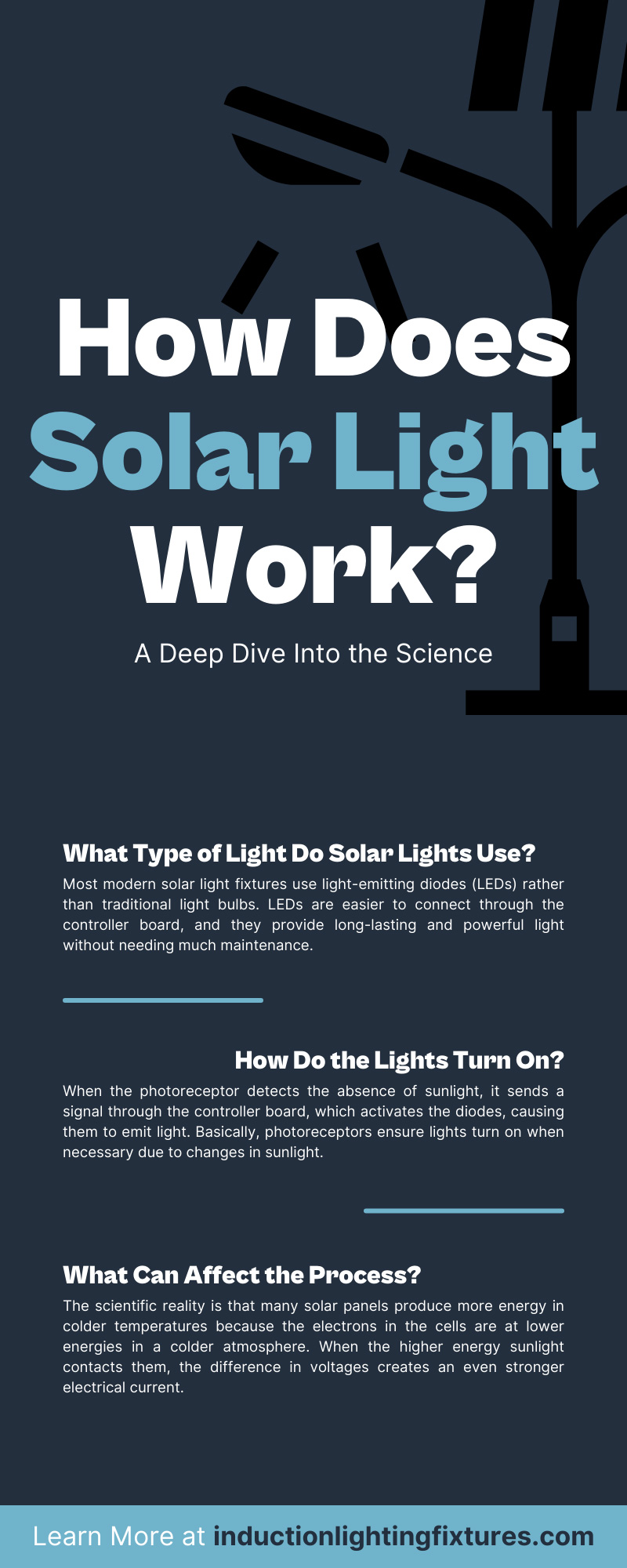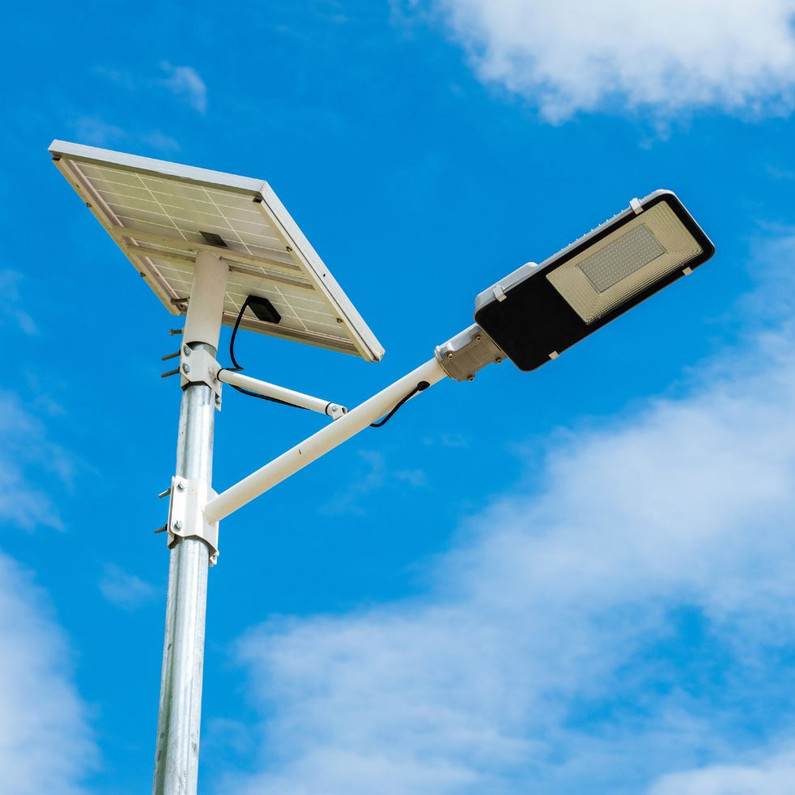How Does Solar Light Work? A Deep Dive Into the Science
There are multiple advantages to using solar lighting. First, it’s a sustainable source of energy that provides powerful and long-lasting lighting. Many businesses enjoy converting to solar lighting because they save a lot of money on their monthly utility bills and spend less time, money, and effort on maintenance.
Solar lights are great for the environment, great for businesses, and great for building a green reputation. However, many people may need help understanding exactly how solar lights work and why and how we convert energy into usable light. Today, Induction Lighting Fixtures is here to dive deep into the science and explain how solar lights work.
The Main Components of Solar Lighting
The first step to understanding the science behind solar lighting is to understand what goes into a solar-powered lamp. Nearly every solar-powered light fixture, from the smallest garden lamp to the tallest streetlamp, has some of these components to keep things running:
- Solar Panel
- Diodes
- Battery
- Controller Board
- Photoresistor
These primary pieces all have their own role in helping your fixture absorb, store, create, and emit light. They act in shifts, and each plays a part in the process that helps keep things running for as long as possible.
How Do Solar Cells Absorb Energy?
The biggest part of diving deep into the science of how solar lights work is understanding solar panels and how they collect energy. Solar panels work thanks to the photovoltaic effect. While these solar cells often look like unassuming dark glass, there’s a lot more that goes on beneath the surface.
All solar light is a light dose of radiation, which is why people need to wear sunscreen when they expose themselves to excessive amounts of sunlight. Much like with nuclear power, the goal of solar power is to convert radiation into an electrical current.
The solar cells in your light fixture are several layers of different materials—commonly silicone—that act as a semiconductor. Each solar cell has a positive and negative conductor that’s crucial for creating power.
When radiation from sunlight goes into the solar cell, that radiation excites the negatively-charged electrons, and they force their way into the positively charged layer. Instead of getting pushed back, the positively charged areas take those invasive electrons and slide them off the cell into the battery as an electrical current.
Where Does the Power Go?
When solar-powered technology was in its early stages, many people laughed at the idea of needing lights that relied on the sun. The logic was that the sun was already out, so we didn’t need lights. Many people even bought and gave solar-powered flashlights as gag gifts.
But solar-powered light doesn’t work only when the sun is out. The positively charged conductors in the solar cell send radiation in the form of an electrical current to a battery bank. These batteries collect and store the electrical current and redistribute it when the lights turn on. Thanks to the battery, the power can build up during the day and discharge during the night.
What Type of Light Do Solar Lights Use?
Most modern solar light fixtures use light-emitting diodes (LEDs) rather than traditional light bulbs. LEDs are easier to connect through the controller board, and they provide long-lasting and powerful light without needing much maintenance.
LEDs work when the electrical current passes through them, which causes them to make a photon, or light, reaction. This process is called electroluminescence. They often rely on a positive anode and a negative cathode to maintain the current constantly moving through it, much like the positive and negative sides of a battery.
How Do the Lights Turn On?
Many exterior lighting fixtures, solar-powered or otherwise, have a way to turn on automatically when the sun starts to go down. Attached to the controller board of your solar light is a small device called a photoreceptor. As the sun begins to go down, your solar panels slow down, collecting and converting less energy. When the photoreceptor detects the absence of sunlight, it sends a signal through the controller board, which activates the diodes, causing them to emit light. Basically, photoreceptors ensure lights turn on when necessary due to changes in sunlight. This is more efficient than using an ever-changing timer or risking human error in turning them on manually.
After the photoreceptor turns the light on, it will remain on until reemerging sunlight causes the photoceptor to turn it off again or the battery runs out of stored power. With many commercial light options, manufacturers supply a large and powerful-enough battery to last more than a typical night in most regions. Though naturally, geographical locations and times of year may impact how much sunlight a region gets per day.
What Can Affect the Process?
Despite all the capabilities and potential of exterior solar lighting, many people still fall into believing common misconceptions about how it works. For example, some people believe that solar lights are less beneficial in the winter when the temperatures go down. This misconception comes from the idea that the heat from the sun is what makes solar panels work, not the actual light. The scientific reality is that many solar panels produce more energy in colder temperatures because the electrons in the cells are at lower energies in a colder atmosphere. When the higher energy sunlight contacts them, the difference in voltages creates an even stronger electrical current.
Having obstructions that block sunlight from getting to solar panels is the biggest issue negatively affecting how much energy your solar lights can produce. Some of the most common blockades are trees or bird nests, but the natural build-up of snow, dirt, or dust can also impact things. Therefore, it’s a good idea to check and clean your panels every few months to ensure they’re getting as much power as possible.
To learn more about industrial solar lighting, Induction Lighting Fixtures has a wide range of commercial exterior light options. Find the panels and fixtures you need for your property, and consult our helpful blogs for more details on installation, maintenance, and safety standards. If you have any additional questions, comments, or concerns, please don’t hesitate to contact us anytime, and a helpful member of our team will be happy to assist you.

Recent Posts
-
Spotlight - The IL-SPG54 Smart Solar Walkway Light: Where Performance Meets Simplicity
Introducing the IL-SPG54 Smart Solar Walkway Light: Where Performance Meets Simplicity When it comes …Jun 16th 2025 -
Corn Bulb Sale - While supplies last!
⚡ Limited Time Sale – BLE Series Corn Lamps Starting at $24.99! Stock up now while supplies la …Jun 11th 2025 -
Dark Sky Lighting in Breckenridge Colorado. Can I retain my existing fixture and still comply with the new Rules?
Breckenridge Colorado Dark Sky lighting has been a focus of ours for the last year. All resid …May 2nd 2025






